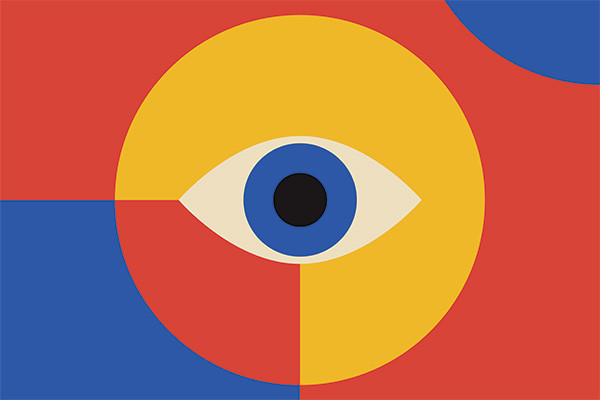
Perhaps you’ve seen this ad about a drug for thyroid eye disease. If so, you may be wondering what thyroid eye disease is — and why the woman in the ad is wearing five pairs of sunglasses at once. Read on for answers.
What is thyroid disease and how does it affect the eyes?
The thyroid gland is a small, butterfly-shaped organ at the front of the neck. It releases thyroid hormone, which helps control many functions in the body. If it releases too much thyroid hormone (hyperthyroidism) or too little (hypothyroidism), bothersome and sometimes serious symptoms may develop, including changes in muscle strength, bowel function, and heart function.
An overactive thyroid gland can cause thyroid eye disease, prompting swelling and inflammation in tissues surrounding the eyes. The condition causes bulging eyes, a dry, gritty sensation in the eyes, tearing, pressure or pain behind the eyes, and blurring or double vision.
As many as half a million people in the US have thyroid eye disease. It affects up to half of people with Graves’ disease, an autoimmune illness marked by an overactive thyroid.
Thyroid eye disease ad: The pitch and the evidence
The ad opens with a woman wearing large, dark sunglasses, identified as a real patient named Jeanne. “With thyroid eye disease,” she explains, “I was always wearing sunglasses to hide my bulging eyes. I wore them just about everywhere.”
She removes her sunglasses to reveal that she’s wearing another pair underneath. In fact, she’s wearing three pairs of sunglasses and later will be wearing five!
As the music turns upbeat, she continues: “But then my doctor recommended Tepezza, a prescription medicine for thyroid eye disease, and I didn’t have to hide so much.”
A drawing of a bulging eye morphing into a more normal eye accompanies her next words: “In a clinical study, more than eight out of 10 patients taking Tepezza had less eye bulging. And nearly seven out of 10 saw improvements in double vision.”
Warnings about this medicine
You know what comes next: a fast-talking voiceover warning of possible side effects. For Tepezza, these include:
- Infusion reactions. Now we learn that Tepezza is an intravenous (infused) medicine. A course of treatment is eight 90-minute infusions, each separated by three weeks. Infusion reactions may be mild or severe, including allergic reactions (such as itching or hives) and other side effects that occur during or just after the infusion (such as fever or sweats).
- When to call for advice. “Tell your doctor right away if you have symptoms such as high blood pressure, fast heartbeat, shortness of breath, or muscle pain,” the voiceover instructs. Keep in mind that most people with high blood pressure have no symptoms, but if severe it can cause headaches, blurry vision, or chest pain.
- Before starting treatment. If you have diabetes or inflammatory bowel disease, or if you are pregnant or planning to become pregnant, you should tell your doctor before starting treatment. That’s because Tepezza may harm a developing fetus or worsen other diseases.
A big finish: Controlling thyroid eye disease
As the commercial winds down, Jeanne is back, removing her fifth consecutive pair of sunglasses to reveal normal-appearing eyes. “I look more like my old self again. Now I wear sunglasses because I want to.”
“Ask your doctor if Tepezza is right for you,” the narrator advises before suggesting a visit to the website for before and after pictures of Jeanne. I checked; they’re impressive.
What the ad gets right
The ad accurately describes
- thyroid eye disease symptoms
- how the condition alters appearance and can cause embarrassment
- results of a single, small study investigating the risks and benefits of Tepezza.
What else do you need to know about treatments for thyroid eye disease?
- You must treat thyroid disease as well as your eye condition. Medicines or surgery are often good options. Radiation therapy may be effective, but sometimes makes thyroid eye disease worsen.
- Selenium, a mineral supplement, is recommended by some experts.
- Quitting smoking is always recommended, partly because smoking may worsen thyroid eye disease.
If thyroid eye disease is mild, moisturizing eye drops, eye shades or patches, or dark sunglasses may be sufficient.
If thyroid eye disease is moderate to severe, options include:
- medicines that suppress inflammation or an overactive immune response. Examples include glucocorticoids, teprotumumab (Tepezza), mycophenolate mofetil (Cellcept), tocilizumab (Actemra), or rituximab (Rituxan).
- surgery to remove excess tissue around the eyes.
Small studies, like the one cited in the ad, may not detect all side effects, especially rare ones.
Last, but certainly not least: Tepezza is expensive. The price for a year of treatment can be $300,000 or more — and insurance coverage varies.
The bottom line
I still don’t know why the woman in the ad wears multiple pairs of sunglasses at the same time. Maybe it’s to emphasize how serious she is about hiding her eyes. Or maybe it’s just a way to grab our attention. Direct-to-consumer drug marketing strategies can be even more mysterious than the illnesses they hope to treat.
If you’re concerned you may have thyroid disease or thyroid eye disease, talk to your doctor. A costly new drug may be an option for some people, but it pays to learn about all options. Academic medical centers, the NIH, or a medical society are more likely to give you reliable and balanced information than a drug ad.
